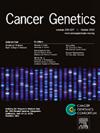Clinicopathological correlation of PTPN3 expression in breast cancer and in silico drug screening against PTPN3 for therapeutics
IF 2.1
4区 医学
Q4 GENETICS & HEREDITY
引用次数: 0
Abstract
PTPN3 regulates cellular signaling and is dysregulated in cancer. There has been less research about the oncogenic impact of PTPN3 in breast cancer patients. This study analyzed PTPN3 mRNA levels and their prognostic significance in breast cancer using TCGA datasets. qRT-PCR was used to assess PTPN3 expression in formalin-fixed, paraffin-embedded Indian breast cancer patient samples (tumor-74, control-36). PTPN3 protein levels (ER-positive 15; ER-negative: 15; distant normal breast tissues: 20) were also immunohistochemically assessed using the H-score method. The biomarker potential was examined using a receiver operating characteristic (ROC) analysis. Docking and molecular dynamics (MD) simulations were used to find PTPN3 inhibitors (PDB ID: 2B49) from 892 FDA-approved natural chemicals in the ZINC database. PTPN3 mRNA and protein expression were significantly higher in breast cancers and associated with clinicopathological variables such as age, ER status, tumor stage, grade, Ki-67 index, menopause, and lymph node metastasis (p < 0.05). ROC analysis revealed an AUC of 0.7654, indicating PTPN3′s biomarker potential. Docking yielded three high-affinity inhibitors: Cyclocort (ZINC000003977777), Toposar (ZINC000003938684), and Tetracycline (ZINC000084441937), with binding energies of -9.3, -8.73, and -8.66 kcal/mol, respectively. MD simulations confirmed stable connections via hydrogen bonds and hydrophobic interactions under minimal constraints. In conclusion, PTPN3 overexpression supports its role as a prognostic biomarker, and Cyclocort, Toposar, and Tetracycline need further confirmation as potential PTPN3 inhibitors.
PTPN3在乳腺癌中表达的临床病理相关性及针对PTPN3的药物筛选治疗
PTPN3调节细胞信号,并在癌症中失调。关于PTPN3在乳腺癌患者中的致癌作用的研究较少。本研究使用TCGA数据集分析PTPN3 mRNA水平及其在乳腺癌中的预后意义。采用qRT-PCR检测福尔马林固定石蜡包埋的印度乳腺癌患者样本(肿瘤74例,对照36例)中PTPN3的表达。PTPN3蛋白水平(er阳性15;er阴性:15;远端正常乳腺组织(20例)也采用H-score法进行免疫组织化学评估。采用受试者工作特征(ROC)分析检测生物标志物电位。对接和分子动力学(MD)模拟从锌数据库中892种fda批准的天然化学物质中寻找PTPN3抑制剂(PDB ID: 2B49)。PTPN3 mRNA和蛋白表达在乳腺癌中显著升高,并与年龄、ER状态、肿瘤分期、分级、Ki-67指数、绝经期和淋巴结转移等临床病理变量相关(p <;0.05)。ROC分析显示AUC为0.7654,表明PTPN3具有生物标志物潜力。对接得到三种高亲和力抑制剂:Cyclocort (ZINC000003977777)、Toposar (ZINC000003938684)和Tetracycline (ZINC000084441937),结合能分别为-9.3、-8.73和-8.66 kcal/mol。MD模拟证实了在最小约束下通过氢键和疏水相互作用建立的稳定连接。综上所述,PTPN3过表达支持其作为预后生物标志物的作用,Cyclocort、Toposar和四环素作为潜在的PTPN3抑制剂有待进一步证实。
本文章由计算机程序翻译,如有差异,请以英文原文为准。
求助全文
约1分钟内获得全文
求助全文
来源期刊

Cancer Genetics
ONCOLOGY-GENETICS & HEREDITY
CiteScore
3.20
自引率
5.30%
发文量
167
审稿时长
27 days
期刊介绍:
The aim of Cancer Genetics is to publish high quality scientific papers on the cellular, genetic and molecular aspects of cancer, including cancer predisposition and clinical diagnostic applications. Specific areas of interest include descriptions of new chromosomal, molecular or epigenetic alterations in benign and malignant diseases; novel laboratory approaches for identification and characterization of chromosomal rearrangements or genomic alterations in cancer cells; correlation of genetic changes with pathology and clinical presentation; and the molecular genetics of cancer predisposition. To reach a basic science and clinical multidisciplinary audience, we welcome original full-length articles, reviews, meeting summaries, brief reports, and letters to the editor.
 求助内容:
求助内容: 应助结果提醒方式:
应助结果提醒方式:


